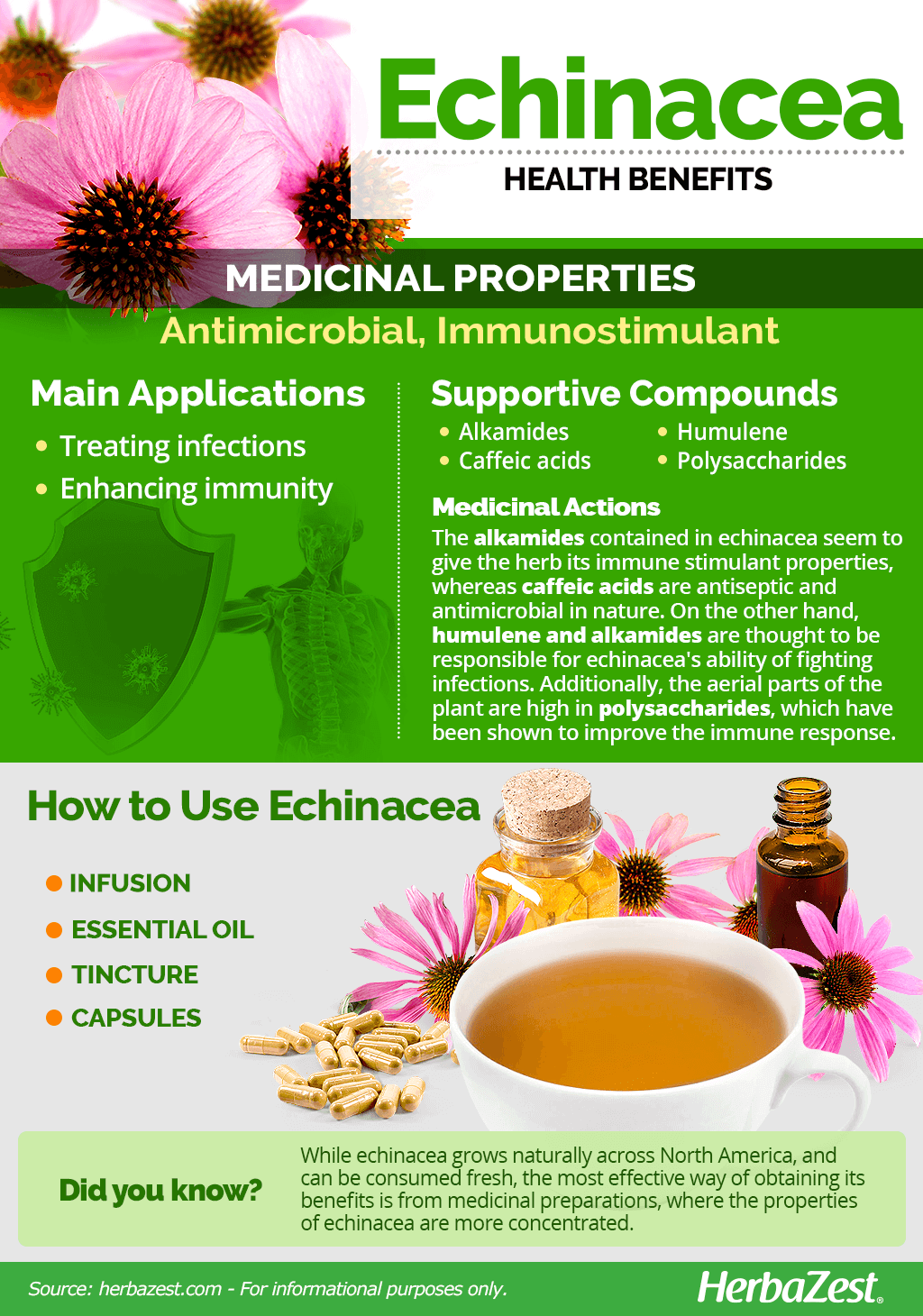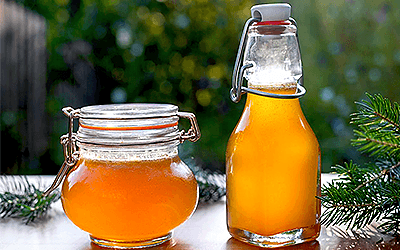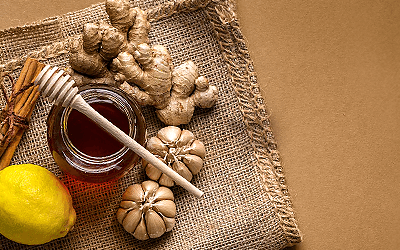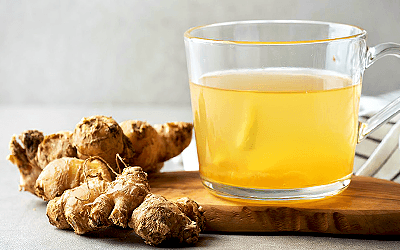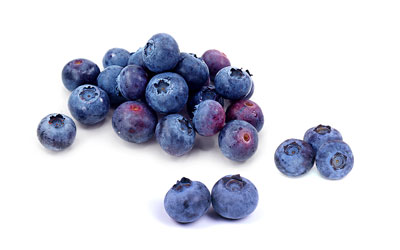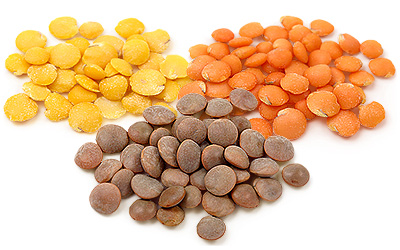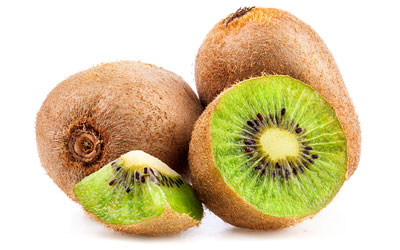A uniquely American herb, echinacea, also known as purple coneflower, has enjoyed a reputation as a medicinal wonder since its worldwide discovery, distinguished even today as the most popular herbal remedy in the United States. Native American tribes have traditionally used the echinacea plant for everything from toothaches to snake bites, including throat and eye infections, and modern science has corroborated many of its alleged benefits, revealing its pharmacological potential.
Echinacea Medicinal Properties
Health Benefits of Echinacea
The echinacea herb has a long history of medicinal uses. It has been traditionally prescribed to treat a myriad of health conditions; however, echinacea properties have been shown to be mainly useful for:
Treating infections. Echinacea medicinal properties have proven effective in the treatment of viral and bacterial diseases, particularly respiratory and urinary tract infections.
Enhancing immunity. Echinacea has immune stimulant properties, which help prevent the attack of harmful pathogens and aid recovery.
Along the centuries, echinacea health benefits have found a number of folk applications, which include:
Disinfecting wounds and scrapes. The antiseptic properties of echinacea have been traditionally used to sanitize open wounds and prevent infections.
Lowering inflammation. Echinacea's anti-inflammatory properties have long been used for the relief of cough, cold, and throat irritation.
How It Works
The exact compounds responsible for the medicinal properties of echinacea are still not entirely understood, but the echinacea herb has been found to contain fat-soluble alkamides, caffeic acid, and polysaccharides, whereas its volatile oil contains humulene, which in vitro studies have suggested to possess anti-inflammatory effects.
The alkamides contained in echinacea seem to give the herb its immune stimulant properties, whereas caffeic acids are antiseptic and antimicrobial in nature.
On the other hand, humulene and alkamides are thought to be responsible for echinacea's ability of fighting infections.
THE ABOVE-GROUND PARTS OF THE PLANT CONTAIN POLYSACCHARIDES THAT CAN IMPROVE IMMUNE RESPONSE.
Other herbs that enhance immunity are astragalus, cabbage, and noni, while calendula, garlic, jewelweed, nasturtium, and lime also have antimicrobial properties.
Echinacea Side Effects
Echinacea is likely safe for most people when taken by mouth. The herb rarely triggers negative reactions; however, there are potential side effects to watch out for, including: fever, nausea, vomiting, upset stomach, diarrhea, unpleasant taste, headache, dry mouth, dizziness, and joint and muscle pain.
When applied topically, echinacea can also cause minor skin irritation.
Cautions
Individuals who are sensitive to Asteraceae species, such as ragweed, mums, or daisies should exercise caution when taking echinacea, since this herb can also trigger allergic reactions.
Likewise, those who suffer from auto-immune disorders, such as multiple sclerosis (MS) lupus, or rheumatoid arthritis should also use echinacea with caution, since consuming this herb can worsen these conditions.
While consuming echinacea is fairly safe for women who are pregnant or breastfeeding, little research has been done on its effects, so during pregnancy or lactation women should consult a physician before taking the herb in medicinal doses.
- Medicinal action Antimicrobial, Immunostimulant
- Key constituents Alkamides, caffeic acids, humulene, polysaccharides
- Ways to use Capsules, Freshly ground, Tincture, Essential oil, Dried
- Medicinal rating (2) Minorly useful plant
- Safety ranking Safe
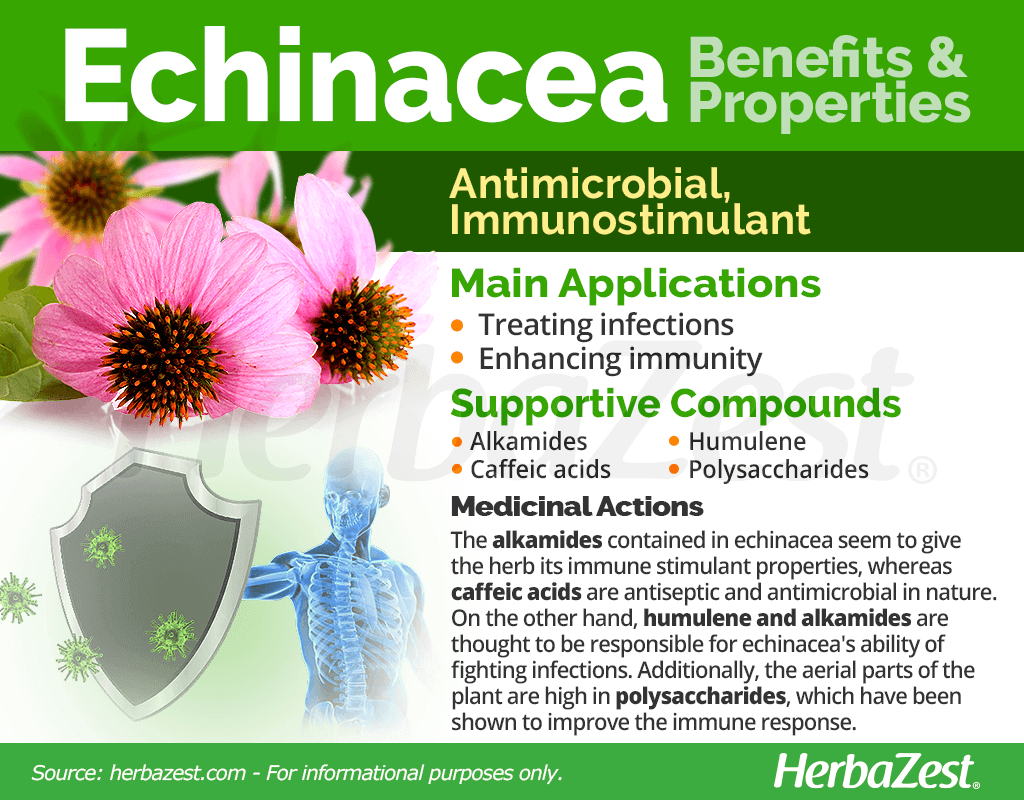
How to Consume Echinacea
Echinacea can be consumed in its raw state, since it can be found growing naturally across North America; however, the most effective way of obtaining echinacea health benefits is from medicinal preparations, where its properties are more concentrated.
Natural Forms
Infusion. The root of echinacea possess powerful antimicrobial and anti-inflammatory properties. When brewed, it is useful for alleviating colds and soothe throat, as well as for relieving joint and muscle pain.
Herbal Remedies & Supplements
Essential oil. Due to its high amount of humuline and alkamides, echinacea essential oil has been shown to strength immunity and ward off infections.
Tincture. This concentrated preparation is high in alkamides, and must be diluted in a glass of water in order to treat respiratory infections.
Capsules. Echinacea supplements are widely preferred to treat respiratory and urinary tract infections, due to their high concentration of active compounds.
- Edible parts Flowers
- Taste Bitter
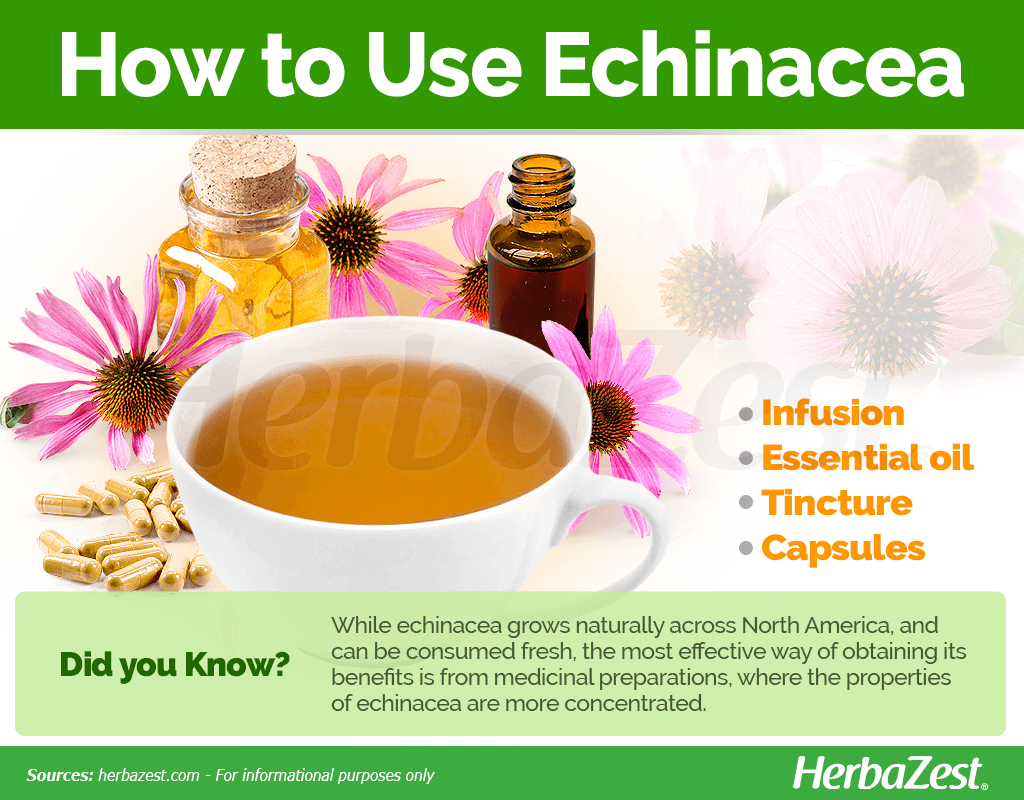
Growing
Native to the cold and temperate climates of North America, echinacea is a perennial herb, particularly abundant in the eastern and central regions of the continent, where it grows naturally in grasslands and open wooded areas.
Growing Guidelines
The echinacea plant is drought-tolerant , and can be grown in a wide range of soils, from gravel to loam, as long as adequate drainage is provided.
Echinacea best thrives in cool, temperate climates, with initial growing temperatures between 65 - 70°F (18 - 21°C) and has sufficient sunlight.
The ideal range of pH for echinacea is slightly acidic to neutral (6.1 - 7.3)
Echinacea seeds should be planted in the spring and will germinate after 10 - 30 days.
Natural rainfall may be enough to sustain the plant without additional watering.
Adding nitrogen to fertilizer may result in better yields.
The roots of echinacea will be ready for harvest in the fall.
- Life cycle Annual
- Harvested parts Flowers, Leaves, Stem, Shoot
- Light requirements Full sun
- Soil Medium (loam)
- Soil pH 6.1 – 6.5 (Slightly acidic), 6.6 – 7.3 (Neutral)
- Growing habitat Cool temperate regions, Temperate climates, Woodlands
- USDA Plant Hardiness Zones 4a, 4b, 5a, 5b, 6a, 6b, 7a, 7b, 8a, 8b, 9a, 9b
- Pre-germination seed treatment Stratification
- Planting time Spring
- Plant spacing average 0.5 m (1.64 ft)
- Propagation techniques Cuttings
- Potential insect pests Leafhoppers
- Potential diseases Aster yellows
Additional Information
Plant Biology
Echinacea, also known as purple coneflower, is a perennial herb that can grow up to 47 inches (120 cm) in height and 20 inches (50 cm) in width. It features several individual stems ending in recognizable pink to light purple flowers. Leaves are covered in coarse hair, and the spiny central cone produces yellow pollen. Many of the herb's nutritional properties reside in its roots, though the entire plant offers healthful benefits.
Classification
Echinacea purpurea is a member of the Asteraceae family, sharing its characteristic star-shaped petals with 23,000 other species, such as chamomile (Matricaria chamomilla), dandelion (Taraxacum officinale), and marigold (Tagetes erecta). Echinacea, with its prickly scales and its large conical seed head, received its name because of its resemblance to a hedgehog (the hedgehog's Greek name is echinos).
Varieties and Subspecies of Echinacea
Dozens of cultivars of Echinacea purpurea have been developed, differing primarily in their petal color, their center shape and color, and other physical characteristics. For example, 'White Swan' has ivory petals and a yellow center, 'Sundown' touts orange petals and a flat center, 'Fatal Attraction' has black stems and deep magenta petals, and 'Ruby Giant' grows 4 - 12 inches (10 - 30 cm) than most other cultivars.
11 distinct species belong to the Echinacea genus, but Echinacea purpurea, or 'purple coneflower', is the most commonly used for medicinal purposes. Their differences are based on chemical ratios present in the roots. Other daisy-like varieties, however, such as Echinacea paradoxa and Echinacea angustifolia, range in color and in the shape of their leaves
Historical Information
Echinacea was historically considered a "cure all" herb in American folk medicine. Archaeologists have found evidence that Native American tribes have used it for over 400 years to treat infectious diseases, such as scarlet fever, syphilis, malaria, blood poisoning, and diphtheria.
European settlers in the area discovered echinacea's medicinal value as early as the 17th century. The first pharmaceutical product featuring the herb was released in 1895, but the popularity of echinacea reached all-time highs by the 1900's, when Switzerland and Germany started to capitalize on its commercial production in Europe.
Echinacea roots remained as an official drug in the National Formulary of the USA until 1950, but the medicinal use of the purple coneflower fell out of favor with the discovery of antibiotics.
Economic Data
Though relatively far behind its counterparts in terms of worldwide consumption - it has little history of use outside of Western countries - echinacea cultivation still generates a great deal of revenue for its use in herbal medicine and supplements. A 2002 survey of American adults found that 40% had utilized the herb in some form over the past year, contributing to yearly sales that are estimated at $58 million USD. Germany is also a notable source of echinacea, boasting the production of more than 200 different supplements that feature the herb.
Popular Beliefs
Echinacea has always been controversial in the arena of modern medicine. While its immune stimulant actions have proven useful to some extend, there is no indication that the herb alone can be used as a substitute of prescription drugs. However, echinacea is widely popular in some countries, like Germany, where its active compounds are injected, primarily as an alternative to flu shots.
Other Uses of Echinacea
Gardening. Prized for its trademark purple petals and low-maintenance growth, echinacea is admired as an ornamental plant in much of the United States.
Ecological balance. Echinacea plants are useful for attracting small-scale wildlife, as nectar-loving insects and birds are drawn to its pollen and seeds.
Sources
- A review of the taxonomy of the genus Echinacea, 1999, pp. 482–489
- Echinacea 2000: Technical Crop Report, p. 4
- Forschende Komplementärmedizin und Klassische Naturheilkunde, History of a Plant: the Example of Echinacea, 2003
- Perspectives on New Crops and New Uses, A review of the taxonomy of the genus Echinacea, pp. 482-489
- USDA Plants Database, Eastern Purple Coneflower
- Encyclopedia of Herbal Medicine, p. 94
- MedlinePlus Herbs and Supplements, Echinacea
- NCCAM Herbs at a Glance, Echinacea: Science and Safety
- Royal Horticultural Society, 'Echinacea purpurea'
